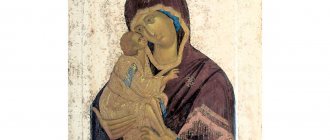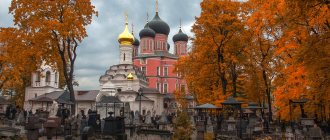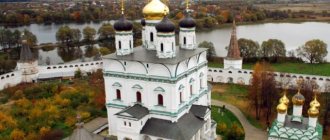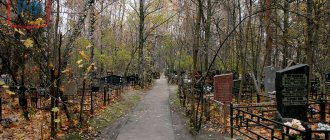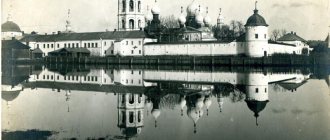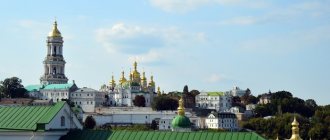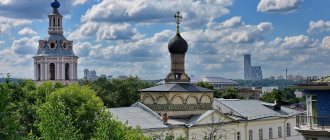The Don Stavropegic Monastery in Moscow, founded at the end of the 16th century, is a popular destination among pilgrims. Thanks to the intercession of the Don Icon of the Mother of God, the city was saved from the attack of the Tatar army of Khan Kazy-Girey. Grateful people founded a monastery named after the miraculous image.
During the history of its existence, the monastery has gone through different times, but today it is open to believers, services are held in the cathedrals, restoration work is carried out on the territory, there are icon painting, gold embroidery and restoration workshops, a Sunday school, and a youth club. The monastery has 2 farmsteads, one is located in the Moscow region in the village of Zelenogradsky, the other is in the Ryazan region in the village of Knyazevo.
Architectural ensemble of the monastery, © Nomad
The primate of the Donskoy Monastery is His Holiness Patriarch Kirill of Moscow and All Rus', the vicar is His Eminence Thomas, Bishop of Bronnitsky, Vicar of the Holy Patriarch of Moscow and All Rus'.
Believers strive to venerate shrines located in cathedrals and churches - miraculous icons, particles of holy relics. The monastery attracts not only pilgrims, but also local residents and tourists who want to admire its architectural ensemble and feel the special atmosphere that reigns here. The necropolis located on the territory is also of great interest - the burial place of prominent representatives of society from different times. Also worthy of attention are the high reliefs in the monastery of the historical building of the Cathedral of Christ the Savior, which was destroyed in the 1930s.
Entrance to the Donskoy Monastery on the Google panorama of Moscow:
Schedule of services of the Donskoy Monastery
Church services at the Donskoy Monastery are held daily. Believers can attend a fraternal prayer service, hours, Divine Liturgy, and Evening services.
Schedule of services on weekdays:
- at 8:00 - Divine Liturgy
- at 16:40 - Evening service.
On Saturdays:
- first Liturgy - at 7:00
- second Liturgy - at 9:00
- All-night vigil - at 17:00.
On Sundays:
- 7:00 - early Liturgy
- 9:00 - middle Liturgy
- 10:00 — late Liturgy
- 16:40 - evening service.
On the eve of church holidays, an All-Night Vigil is held. The Sacraments of Baptism, Wedding, and Unction are performed in the monastery.
Detailed schedule of services on the official website of the Donskoy Monastery
Temple of John Climacus and Temple of Alexander Svirsky, © Nomad
Old Don Cemetery, Moscow.
The main value of the monastery is, of course, the largest preserved noble cemetery (necropolis) in Moscow from the 18th-19th centuries, which occupies more than half of the Donskoy Monastery. In 1771, by order of Catherine II, it was forbidden to bury people on the territory of cities. The aristocrats of Moscow began to move their family tombs to monasteries outside the city limits (at that time the Donskoy Monastery was located outside of Moscow). As a sign of this event, a monument to Catherine II was erected in the Donskoy Monastery.
The best places for burials were revered in the Small Cathedral (Patriarch Tikhon) and around it (Golitsyns, Naryshkins, Trubetskoys, Dolgorukovs, etc.).
Many eminent nobles built small churches and chapels for their tombs: the Temple of St. John the Ladder, late 19th century, made for General Tereshchenko (in the photo, a real work of art with small green turrets) and the chapel of the merchant Prostyakov’s family (the gray square building in the photo to the left of the temple) .
Temple of the Archangel Michael, tomb of the princely Golitsyn dynasty.
Temple of Alexander Svirsky (yellow rotunda in the photo below).
Relatives (grandmother, uncle and two aunts) of Pushkin are buried on the territory of the necropolis. Commemorative plaques have now been installed.
And also his friends
and friends, such as Sobolevsky.
Relatives of Tolstoy and Turgenev rest in the necropolis,
19th century Russian philosopher Chaadaev
and many others. The photo below shows a list of the main burial places of the southern part of the Donskoy Monastery before the 19th century.
In the northern part there are later burials: Russian mechanic Zhukovsky,
Russian artist Perov,
our great contemporary Solzhenitsyn.
Necropolis of the Donskoy Monastery
On the territory of the Donskoy Monastery there is also a necropolis - a burial place for prominent representatives of various fields - religion, science, literature, art. Many visitors note that despite the fact that this is a cemetery, they did not have a depressing impression of the place, because it has an aesthetic component; many monuments can be considered as works of art, masterfully and soulfully designed by talented sculptors. Here you can see slabs of white stone, pyramids, urns, vases, sculptures of angels and mourners, and entire architectural and decorative compositions.
The cemetery of the monastery was considered aristocratic, because prominent representatives of the nobles and wealthy merchants found rest here. Among the famous surnames that are inscribed on the gravestones are the Golitsyns, Volkonskys, Vyazemskys, Dolgorukovs, Tolstoys, Naryshkins and others. Here are also the graves of a landowner known for her cruelty, who received the nickname Saltychikha, as well as her husband.
Here you can see the graves of the historian Klyuchevsky, the philosopher Chaadaev, the architect Bove, the writers Sumarokov, Kheraskov, Sollogub. In the necropolis of the monastery lie the remains of relatives of the poet Pushkin, playwright Griboedov, and Leo Tolstoy. Famous personalities are buried within the walls of the monastery to this day; in 2008, the writer Solzhenitsyn was buried here.
Necropolis, © Nomad
Temples of the Donskoy Monastery
On the territory of the monastery there are:
- Small Cathedral
- Great Cathedral
- Sretensky Church
- Gate Church in honor of the Tikhvin Icon of the Virgin Mary
- St. Michael's Church
- Temple in honor of St. Alexander of Svirsky
- Gate Church in honor of the righteous Zechariah and Elizabeth
- Temple in honor of St. John Climacus
- Church in honor of St. John Chrysostom and the Great Martyr Catherine
- Church in honor of St. Tikhon
- Temple in honor of the Holy Great Martyr George the Victorious
- Church in honor of the Holy Prince Alexander Nevsky
- Temple in honor of St. Seraphim of Sarov and St. Anna Kashinskaya.
Small Cathedral of the Donskoy Monastery
The temple in honor of the Don Icon of the Mother of God, now called the Small Cathedral, was built in 1593. It became the first stone building on the territory of the established monastery. There is a version that the temple is the creation of a talented architect of that time, Fyodor Kon. Over time, the appearance of the building changed significantly; a refectory and chapels were added to it, and later a hipped bell tower also appeared. In 1925, Patriarch of Moscow and All Russia Tikhon was buried in the refectory of the church. In 1991, as a result of arson in the temple, its refectory was almost completely destroyed by fire. During the restoration work, the untouched relics of Patriarch Tikhon were discovered.
Small Cathedral, © Nomad
Great Cathedral of the Donskoy Monastery
Consecrated in 1698, the temple attracts attention with its majesty; red brick was used in its construction. The cathedral has five chapters and stands on a high basement. Under Soviet rule, it housed exhibitions of an architectural museum, thanks to which the iconostasis and paintings were preserved. After the return of the cathedral to the patriarchy, large-scale restoration work was carried out in it, which made it possible to restore the front porch to its original appearance, restore the unique iconostasis and, in general, return the cathedral to its former grandeur.
Temple of Seraphim of Sarov in the Donskoy Monastery
The temple-tomb in honor of St. Seraphim of Sarov was erected in 1914 on the territory of the new cemetery of the monastery. Its lower church was consecrated in honor of the holy blessed Anna Kashinskaya. In the 1920s, the temple was rebuilt into a crematorium, by the way, the first in the entire Soviet Union. After the work was completed, the building no longer resembled a religious building. In the mid-1990s, the temple began to be restored, and today services are held there.
Scheme of the Donskoy Monastery
Monastery of Dmitry Donskoy in Moscow. A story in a hundred words
I will try to quickly and simply present the most interesting and important moments from the history of the monastery.
- The Donskoy Monastery was founded in Moscow by the son of Ivan the Terrible, Fedor, in 1593. Even then, the Small Cathedral of the Donskoy Monastery was built. It turns out to be more than 400 years old.
- It is named in honor of the Donskaya Icon of the Mother of God, the same one with which Dmitry Donskoy was blessed at the Battle of Kulikovo.
- The Moscow Donskoy Monastery became very rich and important over time. Kings come here to pray.
- In 1698 the Great Cathedral of the Donskoy Monastery was built. Now, as soon as you enter the gate, you walk straight towards him along the road. Go into it, there is simply a gorgeous iconostasis and it’s very ancient.
- In 1771, Archimandrite Ambrose was killed by a crowd on the territory of the monastery. There was a plague in Moscow at that time, and people went to the gates of the monastery, where the miraculous icon hung. The archimandrite feared that crowds of people would spread the infection even more. So he hid the icon, for which he was torn to pieces by the crowd. It's somehow unfair.
- In 1764 the monastery was called: Donskoy stauropegial monastery. This means that he reports directly only to the patriarch.
- Since 1918, the Holy Don Monastery in Moscow has been closed by the Bolsheviks. It later had many different kinds of museums, anti-religious and others.
Icons and relics
The monastery houses miraculous icons, particles of relics and other shrines. One of the main shrines is the icon of Our Lady of the Don, painted in the 16th century; it is located in the iconostasis of the Great Cathedral. Pilgrims also have the opportunity to venerate the image painted by Theophanes the Greek. It is kept in the Tretyakov Gallery, but every year on September 1 it is delivered to the monastery for the Divine Liturgy.
Also in the Great Cathedral are kept the holy relics of St. Tikhon. The most revered images of the Small Cathedral are the icon of the Mother of God “The Sign”, the Feodorovskaya icon of the Mother of God, painted in the 18th century, and the Don Icon of the Mother of God of the 18th–19th centuries.
Story
In 1591, Moscow was under threat of attack by the Crimean Tatar army led by Khan Kazy-Girey. The then reigning Tsar Fyodor Ioannovich ordered the organization of a religious procession with the Don Icon of the Mother of God around the city walls. After that, she was placed in a camp church in the place where the Russian army stood before the battle with the enemy. Several local battles took place between the opposing armies, after which suddenly the Tatar army was seized by panic, something suddenly forced them to flee.
Walls and towers of the monastery, © Nomad
The Russians believed that the intercession of the Don Icon of the Mother of God, which had previously supported the Russian army in battles, helped. In 1593, as a token of gratitude to her, a monastery was founded at the site of the troops before the attack of the Tatars, and a cathedral was erected on its territory in honor of the miraculous image. The monastery also served as a fortress, protecting the city from attacks from the Kaluga road. In the second half of the 17th century, a new cathedral was erected in the monastery, named in honor of the Don Icon of the Mother of God; it would later be called the Great Cathedral.
Along with it, the monastery acquired other stone buildings - walls and towers. Due to the ban on burials within the city after the plague epidemic of 1771, representatives of the Moscow nobility began to be buried in the monastery cemetery. During the Patriotic War, the buildings of the monastery were not affected by the fire, but it itself was destroyed and plundered by the French army. After the enemy army left the city, the monastery began to be revived. The monastery is connected with the fate of St. Tikhon, who was imprisoned there after the events of the October Revolution of 1917.
High reliefs on the territory of the monastery, © Nomad
In 1926, the monastery was closed, its servants dispersed and repressed. The territory housed an anti-religious museum, a boarding school and various enterprises. In the 1930s, a museum dedicated to Russian architecture began operating in the monastery. Fragments of Moscow architectural monuments prepared for destruction were transported here. This is how high reliefs of the Cathedral of Christ the Savior, bronze fragments from the Arc de Triomphe and other architectural forms appeared here.
The good news was the return of the Patriarchate of the Small Cathedral, which became a parish church. The monastery was completely transferred to the Moscow Patriarchate only in 1990. Several small churches have appeared on its territory; to this day, work is underway to restore the architectural ensemble, thanks to which the monastery is being transformed and delights pilgrims and numerous visitors.
Miscellaneous useful
- The Donskoy Monastery in Moscow has an official website. On it you can take a virtual tour of the monastery. Nicely done, by the way, with sound: birds sing, different noises.
- There are excursions to the Donskoy Monastery in Moscow, as well as a pilgrimage service of the Donskoy Monastery, which organizes trips to holy places. You can find out more details by calling: +7 (495) 952-02-63.
- Opening hours of the monastery necropolis: from 08.00 to 18.30.
- One of the especially revered shrines is the relics of Patriarch Tikhon in the Donskoy Monastery. Tikhon was imprisoned here, and then he was buried in the basement of the Small Church. When the temple was being repaired, the ashes were dug up. Now believers can come to him to worship. It is located in the Great Cathedral.
- At the entrance to the monastery territory there are refectories. There you can have a snack with pies and hot tea at a normal price. I liked the lentil pies. This was the first time I ate it with this filling.
- Having passed through the necropolis, go to the wall on which the high reliefs from the Cathedral of Christ the Savior, which was destroyed, are fixed. By the way, benches from that temple now stand at the Tretyakovskaya metro station, and the Okhotny Ryad metro station is paved with marble from it.
- If you go to the new Donskoy cemetery, leaving the gate of the Donskoy Monastery to the left, you will pass a gate behind which there are elements from various churches. I don’t know which ones exactly, but they are quite large and beautiful.
Excursions
Self-guided tours of the grounds are free. There is a pilgrimage service at the monastery that organizes excursions to the monastery and other holy places. Here you can book sightseeing and extended excursions; there is also a program entirely dedicated to the necropolis. The donation amount for excursions is from 1500 rubles. from an individual group. There are also excursions for custom groups, and there are benefits for groups of schoolchildren, students and pensioners.
Prices for excursions to the Donskoy Monastery
How to get to the Donskoy Monastery
You can get to the monastery either by public or by private transport or by taxi.
To the Donskoy Monastery by metro
The nearest station to the monastery is “Shabolovskaya”, from there it is about 1.5 km to the attraction. Coming out of the metro, you need to turn left and go to the tram stop, then you should turn right, moving along Shabolovka Street to the intersection with Pervy Donskoy Proezd. Next you need to turn right and go straight, the monastery will be visible on the left side, you need to walk along its wall to the gate located on the side of Donskaya Square.
You can walk to the monastery both from the Leninsky Prospekt metro station and from the MCC station Gagarin Square. After leaving the station, you need to go right to Vavilova Street and turn left, you should follow it until it turns into Ordzhonikidze Street. Then you need to turn left onto Donskaya Street and, moving along the wall of the monastery, reach the main gate.
Moscow metro map
Cemetery of the Donskoy Monastery in Moscow
Across the wall from the necropolis is the new Don Cemetery.
It is impossible to get from the Donskoy Monastery onto its territory; you must exit the gate and turn left. Walk about a hundred meters and there will be an entrance. There used to be a crematorium there, which was made from the Church of St. Seraphim of Sarov. The church is now operating as a church again and not as a crematorium. What is it like to pray now where dozens of people were burned?
The repressed also burned in the crematorium. They were then buried here in a common grave. Now everything has sprouted grass: you walk on the grass, and it is alive: in that one there is a piece of Tukhachevsky, but in this one - Meyerhold is reaching for the sun.
A very difficult place in terms of energy.
Once in the Donskoy Monastery I met a woman who was the daughter of a repressed man buried in the new Donskoy cemetery. She told a lot, but the only thing I remember was that she, too, as a girl, ended up in prison and that there was a female cellmate there who embroidered a scarf for her husband with a fish bone instead of a needle.
